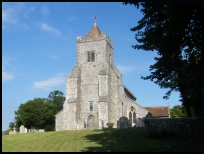| |

|
|
|
| |
 Firle in East Sussex or more correctly West Firle lies just off the main
A27 Eastbourne to Lewes road. Firle in East Sussex or more correctly West Firle lies just off the main
A27 Eastbourne to Lewes road.
It is mentioned as part of the Abbey of Wilton in
the reign of Edward the Confessor (1042 - 1066) this
manor was of great value, and in 1066 after the conquest
the manor was given to the Count de Mortain who had control
of the castle at Pevensey .
The ownership of the manor was held by the Lyvett family
from the early 1300's until 1440 when the land was passed
to the bolney family, whose daughter Agnes married
William Gage and in turn the land passed to the Gage family.
Their son Sir John Gage took over some more of the nearby
manors when his wife's father Sir Thomas St Clere died in
1446.
The family continued in the local manors until 1479 when
the second Sir John Gage was born, who was made a ward of
the Duke of Buckingham when his father died in 1497.
This Sir John was brought up for the court, and in 1513
accompanied Henry VIII on his expedition to France.
Because of his prowess in Battle he was appointed
Vice-Chamberlain to the King. Sir John built much of
the Tudor features of Firle Place.
Sir John's son Edward became the Sheriff of Sussex, and
in 1556 had the dubious honour of supervising the burning
at the stake of the Lewes martyrs .
Another famous Gage was General Sir Thomas Gage who was
the commander who lost Bunkers Hill to the Americans.
Finally the story of Firle and that of the Gages would
not be complete without an account of the greengage.
Thomas Gage who was a botanist and traveller introduced
a small green plum like fruit to England, which he first
grew at Firle Place , the green fruit was named the greengage
in Thomas honour.
This village is associated with the Sussex Bonfire Societies , who provide
noisy processions, unbelievable outfits and fantastic firework displays throughout
the month of November - a spectacle not to be missed. |
|
 Firle in East Sussex is at the base of the South Downs, so the views
are quite pretty, the village high street winds towards
the main A27, but nowadays it is full with parked cars. Firle in East Sussex is at the base of the South Downs, so the views
are quite pretty, the village high street winds towards
the main A27, but nowadays it is full with parked cars.
Firle beacon lies behind the village and at 718ft is one of
the highest peaks in the area, with many walks and rambles.
From the A27 looking north west can be seen Mount Caburn
lying outside Glynde .
Firle Place is a good place to visit with its history
and architecture. |
|
 Firle in East Sussex is a small village with a few local businesses. Firle in East Sussex is a small village with a few local businesses.
The nearest town is Lewes about 4 miles to the north
east, with its shopping centre and supermarkets.
The nearest trains can be caught from Glynde about 1 and
1/2 miles to the north. |
|
| Firle is shown as the red symbol on the map. |
|
|
Nearby Villages
(click on symbol to see the village page) |
| Village= | |
Town= | |
Recorded in Domesday= |  |
| |
|
|
Alciston |
(Fifty thousand tiles on the Barn) | | 2.39 miles |
|
|
Alfriston |
(Smuggling and Ghosts) | | 4.01 miles |
|
|
Arlington |
(Peaceful Saxon Village) | | 4.63 miles |
|
|
Beddingham |
(At the base of Mount Caburn) | | 1.66 miles |
|
|
Berwick |
(Sharpen your arrows on the Church) | | 3.21 miles |
|
|
Bishopstone |
(Largest Tide-Mill in Sussex) | | 3.84 miles |
|
|
Chalvington |
(The miniature church) | | 3.47 miles |
|
|
Denton |
(Earl Godwins Manor) | | 3.27 miles |
|
|
Folkington |
(Teasles and Badgers) | | 5.79 miles |
|
|
Glynde |
(Home of English Opera) | | 1.41 miles |
|
|
Jevington |
(Smugglers and Churchill Tanks) | | 6.76 miles |
|
|
Laughton |
(Knight captures King of France) | | 4.24 miles |
|
|
Litlington |
(Secret marriage of George IV) | | 4.88 miles |
|
|
Lullington |
(destroyed by Cromwell ??) | | 4.42 miles |
|
|
Ringmer |
(Poor Roads and riots) | | 3.57 miles |
|
|
Ripe |
(Earl Harolds estate) | | 3.04 miles |
|
|
Selmeston |
(Tomb to store the Contraband) | | 2.53 miles |
|
|
Tarring Neville |
(The Chest from the Spanish Armarda) | | 2.72 miles |
|
|
Wilmington |
(The Long Man) | | 4.97 miles |
|
|
| Copyright Villagenet 1998-2025 | |
| |
|
|
Local Interest
Just click an image |
|
|
|
|
|
|
|
|
|
|
|
|
|
|
| |